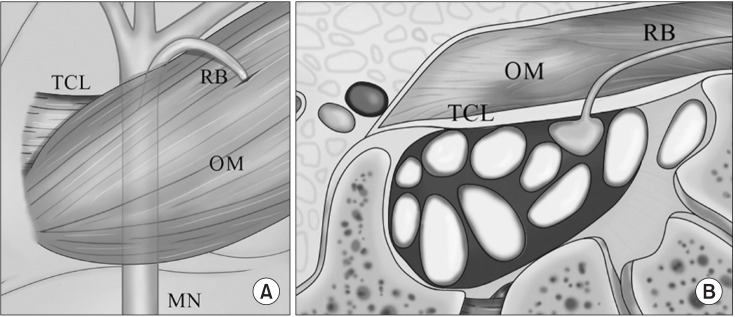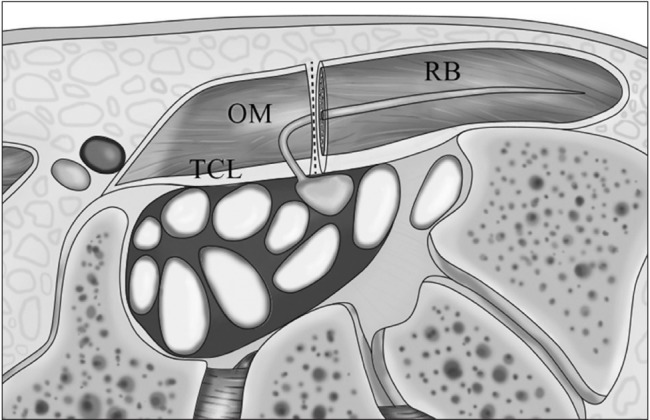Clin Orthop Surg.
2018 Mar;10(1):89-93. 10.4055/cios.2018.10.1.89.
Anatomical Relationships between Muscles Overlying Distal Transverse Carpal Ligament and Thenar Motor Branch of the Median Nerve
- Affiliations
-
- 1Department of Orthopaedic Surgery, MS Jaegeon Hospital, Daegu, Korea.
- 2Department of Orthopaedic Surgery, Prime Hospital, Busan, Korea.
- 3Department of Orthopaedic Surgery, Ilsan Paik Hospital, Inje University College of Medicine, Goyang, Korea.
- 4Department of Orthopaedic Surgery, Kangdong Sacred Heart Hospital, Hallym University College of Medicine, Seoul, Korea.
- 5Department of Orthopaedic Surgery, Samsung Medical Center, Sungkyunkwan University School of Medicine, Seoul, Korea. mjp3506@skku.edu
- KMID: 2405487
- DOI: http://doi.org/10.4055/cios.2018.10.1.89
Abstract
- BACKGROUND
The purpose of the current study is to investigate anatomical relationships between the muscle overlying the distal transverse carpal ligament (TCL) and the thenar motor branch of the median nerve.
METHODS
Of the 192 wrists that underwent open carpal tunnel release, a muscle belly overlying the TCL was observed on the distal margin of TCL in 25 wrists and ligament exposure could not be achieved without transection of it. We recorded surgical findings of these 25 wrists. The origin of the recurrent motor branch arising from the major median nerve was marked on the axial and coronal section diagrams of the wrist.
RESULTS
The presence of muscle overlying the TCL was seen in 25 wrists (21 patients, 13%). The locations of origin were distributed not only on the radial side but anterior or ulnar side of the major median nerve. Abnormal branches originated from the unusual side in 14 cases (56% of those with a muscle overlying the TCL): central-anterior side in eight cases, ulnar-anterior side in five cases, and ulnar side in one case. These anomalous branches were frequently associated with the muscle belly overlying the TCL in our study regardless of the origin site. The branches were prone to cut if careless midline incision along the third web space was performed. Unusual origin and aberrant pathway of the recurrent thenar motor branch were associated with the presence of a muscle overlying the TCL.
CONCLUSIONS
A thorough knowledge of the standard and variant anatomy of the muscle belly and recurrent motor branch in the carpal tunnel is fundamental to prevention of complications such as muscle wasting or atrophy by iatrogenic motor branch injury during carpal tunnel release.
Figure
Reference
-
1. Hurwitz PJ. Variations in the course of the thenar motor branch of the median nerve. J Hand Surg Br. 1996; 21(3):344–346. PMID: 8771472.
Article2. Green DP, Morgan JP. Correlation between muscle morphology of the transverse carpal ligament and branching pattern of the motor branch of median nerve. J Hand Surg Am. 2008; 33(9):1505–1511. PMID: 18984331.
Article3. Lanz U. Anatomical variations of the median nerve in the carpal tunnel. J Hand Surg Am. 1977; 2(1):44–53. PMID: 839054.
Article4. Mannerfelt L, Hybbinette CH. Important anomaly of the thenar motor branch of the median nerve: a clinical and anatomical report. Bull Hosp Joint Dis. 1972; 33(1):15–21. PMID: 5025917.5. Tountas CP, Bihrle DM, MacDonald CJ, Bergman RA. Variations of the median nerve in the carpal canal. J Hand Surg Am. 1987; 12(5 Pt 1):708–712. PMID: 3655229.
Article6. Kozin SH. The anatomy of the recurrent branch of the median nerve. J Hand Surg Am. 1998; 23(5):852–858. PMID: 9763261.7. Shrewsbury MM, Johnson RK, Ousterhout DK. The palmaris brevis: a reconsideration of its anatomy and possible function. J Bone Joint Surg Am. 1972; 54(2):344–348. PMID: 4651265.8. Johnson RK, Shrewsbury MM. Anatomical course of the thenar branch of the median nerve: usually in a separate tunnel through the transverse carpal ligament. J Bone Joint Surg Am. 1970; 52(2):269–273. PMID: 5440004.9. Hollevoet N, Barbaix E, D'herde K, Vanhove W, Verdonk R. Muscle fibres crossing the line of incision used in carpal tunnel decompression. J Hand Surg Eur Vol. 2010; 35(2):115–119. PMID: 19828566.
Article10. Al-Qattan MM. Variations in the course of the thenar motor branch of the median nerve and their relationship to the hypertrophic muscle overlying the transverse carpal ligament. J Hand Surg Am. 2010; 35(11):1820–1824. PMID: 20934817.
Article11. Siverhus SW, Kremchek TE, Smith WR, Basch TM, Drake RL. A cadaveric study of the anatomic variations of the recurrent motor branch of the median nerve. Orthop Rev. 1989; 18(3):315–320. PMID: 2652047.
- Full Text Links
- Actions
-
Cited
- CITED
-
- Close
- Share
- Similar articles
-
- Carpal Tunnel Syndrome with Recurrent Motor Branch Entrapment: A Case Report
- A Case of Strong Palm Compression-Induced Thenar Motor Neuropathy
- Dejerine-Sottas Disease: A Case
- Post-Operative Morphometric Analysis of Carpal Tunnel Syndrome using High Resolution Ultrasonography
- Motor Unit Number Estimation in Thenar Muscles of the Hemiplegic Patients







